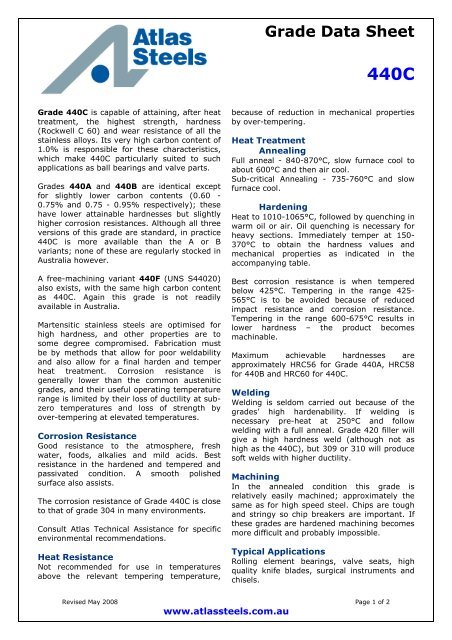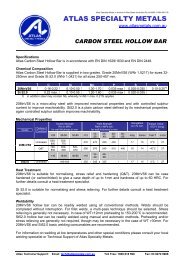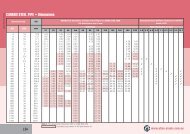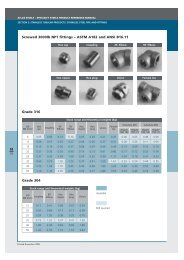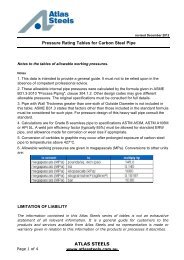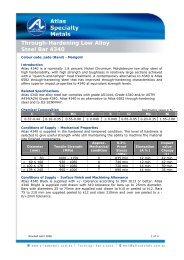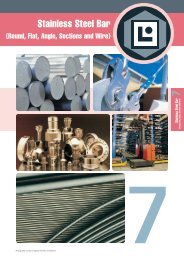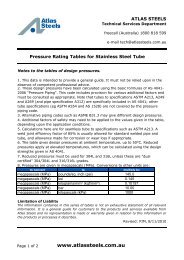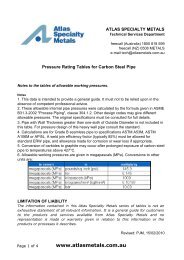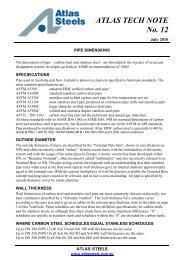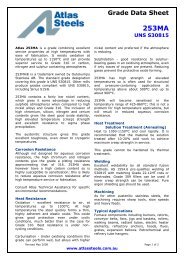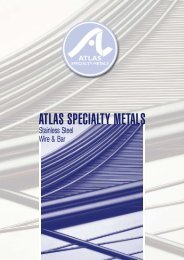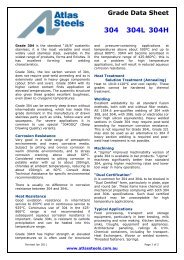Grade Data Sheet 440C - Atlas Steels
Grade Data Sheet 440C - Atlas Steels
Grade Data Sheet 440C - Atlas Steels
Create successful ePaper yourself
Turn your PDF publications into a flip-book with our unique Google optimized e-Paper software.
<strong>Grade</strong> <strong>Data</strong> <strong>Sheet</strong><strong>440C</strong><strong>Grade</strong> <strong>440C</strong> is capable of attaining, after heattreatment, the highest strength, hardness(Rockwell C 60) and wear resistance of all thestainless alloys. Its very high carbon content of1.0% is responsible for these characteristics,which make <strong>440C</strong> particularly suited to suchapplications as ball bearings and valve parts.<strong>Grade</strong>s 440A and 440B are identical exceptfor slightly lower carbon contents (0.60 -0.75% and 0.75 - 0.95% respectively); thesehave lower attainable hardnesses but slightlyhigher corrosion resistances. Although all threeversions of this grade are standard, in practice<strong>440C</strong> is more available than the A or Bvariants; none of these are regularly stocked inAustralia however.A free-machining variant 440F (UNS S44020)also exists, with the same high carbon contentas <strong>440C</strong>. Again this grade is not readilyavailable in Australia.Martensitic stainless steels are optimised forhigh hardness, and other properties are tosome degree compromised. Fabrication mustbe by methods that allow for poor weldabilityand also allow for a final harden and temperheat treatment. Corrosion resistance isgenerally lower than the common austeniticgrades, and their useful operating temperaturerange is limited by their loss of ductility at subzerotemperatures and loss of strength byover-tempering at elevated temperatures.Corrosion ResistanceGood resistance to the atmosphere, freshwater, foods, alkalies and mild acids. Bestresistance in the hardened and tempered andpassivated condition. A smooth polishedsurface also assists.The corrosion resistance of <strong>Grade</strong> <strong>440C</strong> is closeto that of grade 304 in many environments.Consult <strong>Atlas</strong> Technical Assistance for specificenvironmental recommendations.Heat ResistanceNot recommended for use in temperaturesabove the relevant tempering temperature,because of reduction in mechanical propertiesby over-tempering.Heat TreatmentAnnealingFull anneal - 840-870°C, slow furnace cool toabout 600°C and then air cool.Sub-critical Annealing - 735-760°C and slowfurnace cool.HardeningHeat to 1010-1065°C, followed by quenching inwarm oil or air. Oil quenching is necessary forheavy sections. Immediately temper at 150-370°C to obtain the hardness values andmechanical properties as indicated in theaccompanying table.Best corrosion resistance is when temperedbelow 425°C. Tempering in the range 425-565°C is to be avoided because of reducedimpact resistance and corrosion resistance.Tempering in the range 600-675°C results inlower hardness – the product becomesmachinable.Maximum achievable hardnesses areapproximately HRC56 for <strong>Grade</strong> 440A, HRC58for 440B and HRC60 for <strong>440C</strong>.WeldingWelding is seldom carried out because of thegrades’ high hardenability. If welding isnecessary pre-heat at 250°C and followwelding with a full anneal. <strong>Grade</strong> 420 filler willgive a high hardness weld (although not ashigh as the <strong>440C</strong>), but 309 or 310 will producesoft welds with higher ductility.MachiningIn the annealed condition this grade isrelatively easily machined; approximately thesame as for high speed steel. Chips are toughand stringy so chip breakers are important. Ifthese grades are hardened machining becomesmore difficult and probably impossible.Typical ApplicationsRolling element bearings, valve seats, highquality knife blades, surgical instruments andchisels.Revised May 2008 Page 1 of 2www.atlassteels.com.au
<strong>Grade</strong> <strong>Data</strong> <strong>Sheet</strong><strong>440C</strong>Specified PropertiesThese properties are specified for bar product in ASTM A276. Similar but not necessarily identicalproperties are specified for other products such as wire and forgings in their respectivespecifications. These grades are not normally available in flat rolled or fluids products.Composition Specification (%)<strong>Grade</strong> C Mn Si P S Cr Mo Ni N440A440B<strong>440C</strong>min.max.min.max.min.max.0.650.750.750.950.951.20-1.00-1.00-1.00-1.00-1.00-1.00-0.040-0.040-0.040-0.030-0.030-0.03016.0018.0016.0018.0016.0018.00Mechanical Properties - <strong>440C</strong> - typical and specified valuesTemperingTemperature(°C)TensileStrength(MPa)Yield Strength0.2% Proof(MPa)Elongation(% in50mm)-0.75-0.75-0.75HardnessRockwell(HR C)- -- -- -ImpactCharpy V(J)Annealed * 758 448 14 269HB max # -204 2030 1900 4 59 9260 1960 1830 4 57 9316 1860 1740 4 56 9371 1790 1660 4 56 9* Annealed properties are typical for <strong>Grade</strong> <strong>440C</strong> ASTM A276 annealed condition.# Brinell Hardness is ASTM A276 specified maximum for annealed 440A, B and C, hot finished.Physical Properties<strong>Grade</strong>Density(kg/m 3 )ElasticModulus(GPa)Mean Coefficient of ThermalExpansion0-100°C(m/m/°C)0-200°C(m/m/°C)(typical values in the annealed condition)ThermalSpecificConductivityHeatat 100°C(W/m.K)at 500°C(W/m.K)0-100°C( J/kg.K)ElectricalResistivity440A/B/C 7650 200 10.1 10.3 24.2 - 460 600<strong>Grade</strong> Specification Comparison<strong>Grade</strong>UNSEuronormNo No NameSwedishSS(n.m)Japanese440A S44002 - - SUS 440A440B S44003 1.4112 X90CrMoV18 SUS 440B<strong>440C</strong> S44004 1.4125 X105CrMo17 - SUS <strong>440C</strong>These comparisons are approximate only. The list is intended as a comparison of functionally similarmaterials not as a schedule of contractual equivalents. If exact equivalents are needed originalspecifications must be consulted.Possible Alternative <strong>Grade</strong>s<strong>Grade</strong> Why it might be chosen instead of <strong>440C</strong>440A/B Slightly softer and more corrosion resistant grade needed440F High machinability required, with same hardness and hardenability as <strong>440C</strong>420 Lower strength and hardness needed than any of the 440 grades416 Higher machinability required, and the much lower hardness and strength is still adequateLimitation of LiabilityThe information contained in this datasheet is not an exhaustive statement of all relevant information. It is a generalguide for customers to the products and services available from <strong>Atlas</strong> <strong>Steels</strong> and no representation is made or warrantygiven in relation to this document or the products or processes it describes.JISRevised May 2008 Page 2 of 2www.atlassteels.com.au


